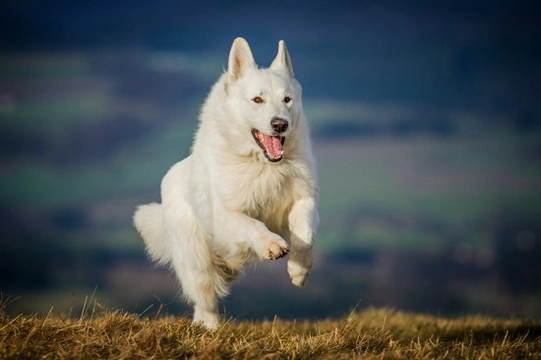
Finding out more about the white German shepherd or white shepherd dog
The white German shepherd dog evolved in the USA and Canada from imported European dogs, and in some countries it is recognised as a breed variant in its own right. The UK Kennel Club classes white colouration in the German shepherd as “highly undesirable”, and as such, white German shepherds are not likely to be suitable for entering in breed shows. However, they are still classed as pedigree German shepherd dogs, assuming that they have the correct lineage and paperwork.
The white German shepherd generally has a longer coat than their standard coloured counterparts, which can be either single or double layered. They also generally have a slightly lighter weight build and are less angular in appearance. While they are not suitable for showing in breed shows due to The Kennel Club’s formal dismissal of their colour, their striking and beautiful appearance, and relative rarity does make them very popular and in demand as pets and companions.
In this article, we will look at the white German shepherd in more detail, including how and why the colour variant comes about and what this means for the dog. Read on to learn more.
The history of the white German shepherd
The white coat colouration of the dog is caused by a recessive gene that was introduced into the German shepherd’s gene pool in a deliberate breeding programme in the late 19th century. A white German shepherd named Greif who was a working-herding dog fathered the line, and his offspring, Horand von Grafrath, is widely recognised as the founder of all of today’s white German shepherds.
While the white German shepherd is of course very similar in appearance to the standard German shepherd, as the colour trait was deliberately and selectively bred, there are a few minor deviations from German shepherd norms. White shepherds are renowned for their high intelligence, sleek, lithe appearance, elegant gait, and of course, their distinctive colour.
The genetics of the white coat colouration
A lot of misconceptions are bandied around regarding the white colouration of the breed, including the supposition that the white colour is due to full or partial albinism. However, modern analysis of the genome of the dog and the specific DNA sequence of the breed indicates that a recessive allele of the E gene is either partially or fully responsible for white or cream coat colouration in the German shepherd dog. When two parent dogs possess the E gene variant, the colour becomes dominant and will always produce offspring with cream or white coats.
White German shepherd temperament
The temperament of the white German shepherd shares all of the best traits of the standard German shepherd, including poise, self-possession, self-confidence and alertness. They are adept at both herding, and guarding and protection roles, and they are open, friendly and trusting with people that they know. They may be wary and observant of strangers, but when properly introduced, they soon relax and become friendly. They are lively, active and happy dogs that like to play and run around, and settle well into a family environment with older children. They will often be very protective over the smaller members of the family too! Their high levels of intelligence and willingness to please make them eminently trainable, and they are also adaptable and able to work confidently in a wide range of situations.
The white German shepherd is fairly vocal, and not shy to bark, make a fuss or howl if they think there is something that you should know, or if they are trying to get your attention!
White German shepherd health
Because the white colouration is not considered to be attributable to albinism, this means that the white version of the German shepherd is not at risk from any of the additional sensitivities or health issues that can accompany true albinism. Ergo, the coat colour itself should not cause any issues for the dog, unlike many other dogs where a white coat colouration is considered to be a flaw that comes accompanied by potential issues at the genetic level, such as full or partial deafness, or skin sensitivities.
The overall health of the white German shepherd is very much on a par with German shepherds of the standard colour, although it is important to note that the white or cream fur of the breed makes them slightly more prone to burning in the sun!
Some health issues that are considered relatively common within the German shepherd breed as a whole, and which it is important to look out for, include hip dysplasia, which pedigree breed lines are often tested for before breeding, and bloat or GDV, a digestive condition.
The average longevity of the white German shepherd dog is ten to eleven years, which is average for dogs of an equivalent size.



